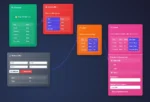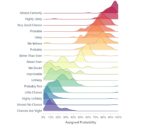
by tyler garrett | Jun 12, 2025 | Data Processing
Imagine having the power to move backward and forward in time at will, effortlessly reconstructing the complete state of your data at any moment—all from a meticulously recorded log of historical events. Event sourcing offers just such a transformative capability to modern software and analytics systems. Embracing this strategy positions your organization to achieve greater consistency, auditability, and scalability in data workflows, empowering you to leverage data innovation as a strategic advantage. But what exactly is event sourcing, and how does it enable us to reconstruct the present state entirely from logged events? As expert technologists committed to enabling smarter decisions through clarity and innovation, we’ll guide you through the essential foundations of event sourcing, offering clarity on its strategic benefits, implementation considerations, and common pitfalls. Let’s dive deep into the art and science of rebuilding application state from historical event logs.
Understanding Event Sourcing: The Basics
At its core, event sourcing is a method of persisting changes in data as a sequence of event records, rather than merely maintaining the current state. When data changes—such as adding a new customer, updating product availability, or creating a sales record—each modification is captured as an event within an immutable log, rather than simply overwriting previous data. Over time, this sequence of logged events forms the immutable history from which the current state of the application is derived.
This technique naturally aligns with an emphasis on clear auditability and traceability. In contrast to standard database practices, where historical context is lost upon each update operation, event sourcing enables systems to reconstruct state at any point in history with precision. Organizations relying heavily on insights extracted through advanced data analytics or visual patterns identified via motion visualizations for time-series patterns can especially benefit from having comprehensive historical records.
Adopting an event-driven architecture not only helps you understand how system state changes over time but enhances transparency across your organizational data pipeline. This foundational methodology can illuminate hidden insights, cleanly structure complex workflows, streamline debugging, and substantially enhance your ability to troubleshoot, reason about, and evolve your software applications.
The Strategic Advantages of Event Sourcing
By embracing event sourcing, organizations dramatically increase their capability to audit and verify historical data states. Each event entry team members or automated processes generate provides explicit context about how and why each change occurred. This comprehensive understanding of data provenance significantly improves decision-making efficiency, risk compliance, and agility to respond to regulatory challenges. It enables leaders to tap into opportunities associated with advanced techniques like synthetic data bootstrapping for privacy-preserving analytics; knowing your historical data in detail allows greater confidence in generating anonymized datasets for broader analytical sharing.
Moreover, event sourcing enhances system scalability and parallelization. Because events are immutable and simply appended, they offer a highly effective foundation for concurrent processing without conflicts. As data requests grow exponentially, modern architectures harness scalable approaches such as push vs. pull data processing architectures seamlessly. Event sourcing complements these architectures, ensuring consistent data availability and state reconstruction without costly real-time consistency enforcement.
Event sourcing also improves resilience and fault tolerance. In the unfortunate event of software failure or hardware disruption, the event log serves as a reliable recovery mechanism. Since the application state can be reliably rebuilt from immutable logs, system administrators can confidently roll back or reconstruct consistent application states, drastically reducing downtime or data loss incurred during incidents.
Leveraging Logs for Historical Reconstruction
In an event-sourced system, the event log becomes the canonical record and single source of truth. Every relevant event—such as “customer created,” “item purchased,” “shipment updated”—is persistently stored with timestamped contextual metadata. To rebuild the current system state, you simply replay these logged events sequentially from the recorded history, applying each modification step by step. This sequential rebuild process mathematically guarantees consistency and correctness of the eventual state.
This replay mechanism unlocks invaluable capabilities for historical analytics. For example, with the event log underpinning your enterprise analytics, implementing advanced data quality mechanisms becomes simpler and more systematic. Pairing event sourcing with workflows enhanced by robust workflow-integrated data quality validation gates ensures anomalies or corrupt state reconstruction scenarios are discovered quickly and systematically.
Furthermore, rebuilding state from logs creates unmatched auditability for regulated industries that must demonstrate precisely how decisions or system states emerged. Compliance and cyberforensic teams appreciate the intrinsic transparency of records in preserving every step of their digital workflow. The inherent proof of lineage furnished via event sourcing can streamline regulatory reviews and greatly simplify data audits.
Challenges and Considerations When Implementing Event Sourcing
Despite its compelling advantages, successful implementation of event sourcing requires careful planning. The intricacies involved can initially complicate transition from traditional “state mutation” models. Properly designing schemas and event structures—perhaps coupling event sourcing with schema registry enforcement in data integration flows—is crucial to ensuring long-term consistency and maintainability. Poorly defined event schemas can hinder analytical clarity or introduce avoidable complexity, negatively impacting downstream processes.
Additionally, event logs can grow rapidly, especially in enterprise-level systems serving millions of event triggers daily. Managing storage efficiently, accounting for storage latency, and employing retention strategies via event compression or snapshotting methodologies become critical considerations. Organizations must proactively plan database scaling strategies and manage storage optimization early.
Furthermore, reconstructing large-scale application states entirely from logs introduces processing overhead. Ensuring event logs maintain proper chronological ordering and efficiently managing the performance or bandwidth cost of replaying these potentially massive datasets demands strategic architectural foresight. Understanding patterns such as the hidden cost of data skew in distributed processing systems will help you anticipate and mitigate reconstruction performance bottlenecks.
Event Sourcing Alignment with the Modern Data-Driven Mindset
Event sourcing dovetails naturally with adopting a contemporary, data-driven approach to software consultancy and analytics—emphasizing continuous learning, experimentation, and rapid adaptability. Integrating this model requires teams to embrace the data-driven mindset: how to think like a modern software consultant. Decision-makers should adopt an iterative approach to innovation, consistently leveraging event source insights as pillars of informed experimentation.
Event sourcing also augments organizations’ ability to extract strategic insights from previously inaccessible data. Coupling it with sophisticated analytics techniques accelerates dark data discovery, illuminating unused information visually by reconstructing historical states to recognize valuable untapped assets. Organizations adept at event sourcing enjoy unparalleled capabilities for historical retrospective analysis, easier debugging, and streamlined innovation recommendations.
Ultimately, event sourcing provides technical leaders the flexibility, reliability, and analytics’ depth required to maintain a competitive edge. It offers a sustainable method of preserving application fidelity, transparency of data workflows, and agility in ever-shifting business and regulatory contexts.
Putting Event Sourcing Into Action
To harness the strategic advantages of event sourcing, organizations must invest in informed expertise, robust frameworks, and precise methodologies. Partnering with skilled professionals—such as their trusted internal analysts or external professionals like our team specializing in advanced analytics and innovation—allows enterprises to avoid common pitfalls, maximize performance, and guide experienced execution.
Our specialized technical experience with event sourcing implementations and advanced analytics architecture, exemplified in our comprehensive Power BI consulting services, positions us uniquely to guide your organization in effectively implementing—and benefiting from—event sourcing. Careful planning, education, collaboration, and alignment with your strategic goals will ensure your successful transition and subsequent sustained value from event sourcing techniques.
Empowered by an informed understanding of event sourcing foundations, you are now positioned to harness this strategic transformation and unlock exponential potential in your data-driven evolution.

by tyler garrett | Jun 12, 2025 | Data Processing
If you’ve ever ventured into the realm of hierarchical data, you’ve surely encountered the bittersweet reality of recursive relationships—those intricate, repeating patterns embedded within trees, graphs, and nested structures that both fascinate and frustrate data architects alike. These recursive nightmares aren’t mere inconveniences; they’re core challenges that influence performance, scalability, and the accuracy of analytics workloads. At Dev3lop, we spend considerable time untangling complexities in hierarchical data structures, turning data-driven dilemmas into clear, actionable insights for businesses. Join us on a journey to demystify these recursive structures, understand their implications, and leverage them expertly to enhance your data strategies.
The Recursive Backbone: Decoding Trees and Graph Structures
Hierarchical data isn’t just common across industries—it’s foundational. Organizational charts, product categories, biological taxonomies, and social networks depend on tree and graph structures. These data models excel in depicting relationships between entities because of their inherently recursive nature, where a parent-child or graph node-edge relationship can indefinitely repeat itself, giving rise to deeply nested hierarchies.
But recursion, while powerful in depicting real-world relationships, can lead to nightmares in unskilled hands. For example, when traversing deeply nested tree structures, you risk performance bottlenecks and inefficient queries. If your data workflow isn’t optimized for recursion, you can quickly degrade from milliseconds to several agonizing seconds or even minutes, depending on the depth and complexity of your hierarchical data.
It’s essential to remember that clear representation isn’t the end goal—it’s the start. You want to ensure that your queries, transformations, and visualizations can handle hierarchical data efficiently. Specific visualization techniques, like those outlined in our guide on horizon charts for dense time-series visualization, illustrate the strategic advantage of selecting appropriate visualization methods to articulate intricate patterns clearly and effectively.
The Complexity Conundrum: Performance and Recursive Data Queries
Recursive structures often imply complex queries, which can strain databases and analytical tools not optimized for these data types. This is because recursive queries typically require the system to traverse hierarchical relationships repeatedly, as they dynamically explore potentially unknown levels of depth. Without careful planning and engineering, such recursion could overwhelm conventional relational database engines, resulting in slow performance and degraded user experiences.
This complexity becomes glaringly apparent with recursive Common Table Expressions (CTEs), a powerful SQL construct used widely to traverse hierarchical data. While recursive CTEs simplify query logic, they can negatively impact performance if not properly structured. Ensuring resilient database management involves applying methods from our expertise in resilient pipeline design with graceful degradation. Incorporating these principles into your data engineering strategy mitigates risks of slow-running, resource-heavy queries, allowing queries to gracefully self-manage when encountering unbounded recursion.
The secret sauce? Carefully indexing hierarchical fields, limiting recursion depths, and judicious data filtering. When approached correctly, recursive querying can shift from being a cumbersome bottleneck to an efficient and elegant technique, seamlessly supporting the business-critical analytics and operations you depend on daily.
Visualization Challenges: Clarity Amid Complexity
Visualizing hierarchical structures is paramount for informed decision-making, but recursive data often muddies visualization attempts. Each additional recursion layer exponentially increases the complexity of visual presentations, creating difficulties for clarity, readability, and communication. Too easily, critical relationships become obscured within overly dense and tangled visualizations, diluting valuable insights that hierarchical data is meant to convey.
At Dev3lop, we recommend utilizing specialized techniques, such as the approaches discussed in quaternion-based visualizations for higher-dimensional data, to simplify complex visual structures effectively. Techniques such as sunburst diagrams, dendrograms, or treemaps can efficiently represent hierarchical information, provided the data visualization method aligns closely with your strategic intent.
Additionally, borrowing from our extensive experience with narrative visualization techniques for data storytelling, hierarchical visuals can be integrated seamlessly into interactive narratives. Dynamic filtering and exploration capabilities, for example, empower stakeholders to manage complexities independently, navigating through recursive structures intuitively to illuminate meaningful outcomes. Ensuring thoughtful visual strategies not only promotes easy comprehension but generates actionable business insights grounded in clear understanding.
AI and Machine Learning: Tackling Hierarchical Complexity at Scale
As data volumes continue to grow exponentially, recursive structures steadily become more complicated, making manual navigation and interpretation practically impossible. Artificial Intelligence and Machine Learning emerge as powerful allies here, capable of understanding and extracting meaning from recursive hierarchical datasets more effectively than traditional methods.
Our exploration into core principles of AI agents and machine learning pipeline design for production highlights how advanced analytical strategies help manage recursion and uncover hidden relationships at scale. Algorithms designed specifically for hierarchical data, including decision tree models, graph neural networks (GNNs), and recursive neural networks (RvNNs), offer groundbreaking possibilities for parsing and interpreting complexity.
With the support of well-crafted machine learning pipelines, businesses can analyze, visualize, and make decisions efficiently—transforming recursive nightmares into strategic assets. Effective AI and ML incorporation ensures your hierarchical analyses remain robust, sustainable, and nimble as the complexity of your data evolves.
Practical Recommendations: Implementing Recursive Data Solutions
Mitigating risks in trees, graphs, and other hierarchical data models involves decisions about tooling, design, and performance optimization. Start by clearly defining the depth, breadth, and usage patterns of your hierarchical data, then select appropriate data structures to support your strategic objectives efficiently.
Structured design guidelines informed by seasoned insights, such as those covered in market trend analysis and demand forecasting, combined with performance-tuned indexing and thoughtful caching of hierarchical information, form a robust foundation for scalable recursive strategy. Alongside your data engineering solutions, prioritize a strategic adherence to contemporary data privacy regulations impacting analytics, thus ensuring compliance, reliability, and trustworthiness of your recursive workflows.
Furthermore, leverage advanced visualization approaches proven to excel in specific data structures, like ternary plots for compositional data, to enhance clarity. A carefully chosen visualization ensures straightforward interpretation, driving data-driven decisions grounded in comprehensive understanding, clarity, and predictability.
Strategic Partnership: Unlock Recursive Data Potential
Hierarchical data structures, despite their complexities and recursion-induced nightmares, contain significant potential when expertly harnessed. However, tackling recursion issues in isolation can place undue strain on internal teams, potentially resulting in missed opportunities or expensive missteps. Partnering strategically with experienced specialists such as Dev3lop’s Data Engineering Consulting Services in Austin, Texas can reduce the challenges associated with recursive data structures efficiently.
As seasoned data strategists, our mission is identifying, mitigating, and refining hierarchical tree and graph complexities in alignment with your organizational goals. By strategically optimizing infrastructure, visualizations, and analytical models, we transform recursive data from a source of anxiety into competitive advantage, fueling informed, swiftly derived insights that lead to smarter decisions and ongoing success in the data-driven transformative landscape.
Ready to overcome the nightmares of recursive workloads? Partnering with our consulting expertise elevates your ability to transform complexity into clarity.

by tyler garrett | Jun 12, 2025 | Data Processing
When the term “big data” emerged, many tech leaders believed that traditional statistical strategies such as sampling would quickly become extinct. However, rather than fading away, sampling has evolved, keeping pace with rapid innovation and the massive data influxes that characterize our modern data landscape. Today, sophisticated sampling methods paired with high-powered computational processes offer an efficient route to actionable insights from vast data resources. By leveraging refined sampling techniques, analytics teams expedite discoveries, improve accuracy, and gain a competitive edge at significantly reduced computational costs. Let’s explore the contemporary tools and tactics that demonstrate why sampling remains a cornerstone of advanced analytics in the era of big data.
The Enduring Power of Sampling in the Age of Big Data
With increasingly sophisticated computing resources available, it’s tempting to imagine that the need for sampling is obsolete—that analyzing entire datasets directly is always feasible or even preferable. However, despite advancements in cloud infrastructure and distributed processing, practical constraints related to processing power, speed, and budget still prevail. For businesses managing workloads from extensive sources like construction management platforms, leveraging targeted sampling methods can dramatically improve analytical efficiency. Consider specialized workflows where teams utilize platforms like Procore; integrating targeted API strategies can streamline data extraction and optimize analytics performance. Our consulting practice often leverages Procore API consulting services to help clients adopt sampling strategies tailored to their varied analytical requirements.
In addition, sampling provides an efficient path to quick iteration—an essential part of hypothesis testing. Modern data-driven enterprises must rapidly evolve their data strategies, test hypotheses, and pivot toward new insights. Comprehensive sampling protocols accelerate this experimentation cycle by providing rapid turnaround of analytical workflows. Early outcomes from robust sample subsets provide direction, informing deeper dives on targeted full-scale datasets later in the analytical journey. In short, sampling still represents a practical, intelligent, and highly adaptable statistical methodology in big data environments, helping decision-makers strike the right balance between speed, accuracy, and cost-efficiency.
Context-Aware Sampling: Tailoring Your Approach
When harnessing big data, not all sampling techniques produce equal outcomes; context matters significantly. By applying context-aware methodologies, organizations obtain accurate subsets of data reflective of nuanced, real-world use scenarios. Embedding sampling within clearly defined data usage policies further optimizes your analytics strategy. A refined approach, outlined clearly in our research on context-aware data usage policy enforcement, helps businesses ensure their sampled datasets are compliant, secure, and purposefully selected.
Context-aware sampling enables data practitioners to extract fragments of large-scale data resources explicitly suited to specific analytical needs. For instance, accurate context-aware sampling helps a retail company leverage the most relevant subsets of historical transaction data for optimizing supply chain management. This approach complements rather than replaces full dataset analytics by providing critical preliminary insights. Efficient sampling can also enhance data privacy measures through intelligent pre-processing, supporting compliance in highly regulated industries like healthcare and finance.
By tailoring the sampling strategy to a defined analytical context—whether it’s predicting demand or assessing sentiment about a newly launched product—data analysts can navigate complexity effectively while ensuring precise representation and actionable insights.
Sampling Methods for Highly Accurate Predictive Analytics
One common goal of big-data usage is driving predictive analytics. Predictive modeling based on sampled datasets can often yield the same or higher performance than models driven by large-scale raw data, where extreme data noise becomes an obstacle. Using predictive analytical strategies, such as those outlined in our guide about accurate demand prediction, allows decision-makers to efficiently utilize sampled subsets to predict complex business events such as seasonal demand fluctuations.
Advanced sampling methods—like stratified sampling or cluster sampling—are especially crucial in predictive scenarios, enabling the careful selection of representative subsets. By thoughtfully choosing subpopulations with distinct characteristics, analysts significantly improve prediction accuracy and precision. For modern statistical practice, methodologies like Bayesian inference also offer compelling sampling-based solutions for modeling uncertainty and making detailed predictions efficiently without the overhead of processing vast streams of complete data.
Ultimately, careful sampling techniques offer valuable refinements in predictive analytics efforts. By acting as a reliable precursor for detailed analyses, sampling methods save valuable resources and effort while ensuring predictions retain a high level of accuracy essential for strategic business decisions.
Strengthening Real-Time Insights with Streaming and Windowing Techniques
Many analytical requirements today involve continuous streams of data generated from IoT sensors, social platforms, or enterprise transactions. In live streaming scenarios, traditional sampling alone may not suffice—the data demands dynamic, reactive sampling capable of processing data inflows continuously. Modern streaming analytics processing window strategies provide robust solutions that not only efficiently ingest data but also guide sampling towards relevant data subsets in real time.
Windowing—partitioning streaming data into discrete intervals—offers precise observability and rapid analytic feedback loops, helping organizations react faster and smarter. With these techniques, analysts retain the benefits of sampling in fast-moving contexts by dynamically focusing on relevant data segments as events occur. Moreover, effective data windowing strengthens both real-time anomaly detection and trending behavior analysis, enabling quicker response times to emerging business events or potential problems. Thus, the combination of sampling and window-based analytics enables firms to leverage big data capabilities while preserving computing resources, improving the real-time responsiveness required by modern enterprises.
Sampling Use Case Spotlight: Sentiment Analysis and Natural Language Processing
The abundant rise in textual data through consumer feedback, product reviews, and social media has created greater requirements for highly efficient analytical methods. Sentiment analysis workflows, like those demonstrated through our NLTK sentiment analysis tutorial, benefit significantly from smart, representative sampling strategies. By extracting subsets based on real-time relevance, analysts gain actionable insights faster without needing exhaustive full-text corpus analysis.
Strategic sampling lets organizations effectively process data from huge document repositories, Twitter streaming data, or customer commentaries. Employing sampling to extract performance indicators like brand sentiment or product satisfaction means analysts can rapidly respond to insights, guide marketing decisions, and improve customer experiences efficiently. Partnering such methods with natural language processing (NLP) adds powerful accuracy to sentiment analysis. Used thoughtfully, sampling transforms sentiment analysis capabilities into scalable, cost-effective, and timely sets of insights, benefiting various business units from product innovation groups to marketing teams.
Ensuring Secure and Scalable Data Sharing Across Sampling Approaches
As organizations handle larger datasets and rely increasingly on sampled data analyses, the distribution and sharing of datasets securely becomes essential. Leveraging established tools and methods, such as sending processed data outputs into managed platforms, offers secure and scalable data handling. For example, our guide on how to send XML data to Google BigQuery using Node.js calls attention to efficient techniques facilitating secure, scalable storage and distribution of sampled data results across cloud environments.
An extension to this consideration includes managing the digital rights and intellectual property of distributed sampled datasets. Implementing effective digital rights management for dataset distribution helps safeguard against unauthorized access or misuse, maintaining the integrity and trustworthiness of sampling analysis outputs. Thoughtful procedures embedded within technical infrastructure and processes ensure responsible dissemination of sampled subsets, preserving business value, data privacy, and compliance standards in a continually expanding world of analytics.
Conclusion: Sampling Remains Critical in Big Data Strategy
Sampling has truly evolved; it hasn’t merely persisted. Through context-aware selection, refined predictive analytics methodologies, streaming windowing innovations, and secure distribution techniques, sampling continues playing a pivotal role in optimizing big data workloads. Ultimately, businesses that understand and adopt modernized sampling approaches harvest significant returns—faster insight generation, improved efficiency, controlled costs, and increased agility within constantly changing data landscapes.

by tyler garrett | Jun 12, 2025 | Data Processing
In the digital era, data doesn’t speak a single language—it’s a multilingual symphony playing across global applications, databases, and interfaces. This multilingual reality brings with it complexities, intricacies, and sometimes outright nightmares in the form of Unicode misinterpretation, encoding chaos, and data corruption. Overcoming these Unicode complexities is not optional: it is imperative if companies strive to maintain data integrity, gain accurate analytical insights, and deliver flawless user experiences. At Dev3lop, our passion for advanced data analytics and innovative data solutions compels us to help decision-makers and technologists master their data landscapes. Let’s dive headfirst into Unicode intricacies, break down the problems, and equip you with confident, strategic solutions to these multi-language text challenges.
Why Unicode and Multi-Language Support is Critical to Modern Data Strategy
Operating globally means your products, interfaces, and analytics pipelines regularly encounter diverse datasets in multiple languages and scripts. Modern data processing requires meticulous attention to Unicode to ensure accurate, interpretable, and reliable analytics. If your dashboards misrepresent text encoding, your data becomes fundamentally flawed. Moreover, machine learning models relying heavily on text embeddings require clean, uniformly encoded texts to correctly extract semantic meaning and context. Our experience in building robust analytics frameworks emphasizes that accurate Unicode handling isn’t merely aesthetic—it’s directly tied to data confidence and strategic success.
Embedding-based applications, as we covered in our comprehensive analysis of vector database selection criteria, necessitate reliable multilingual processing and storage. Inconsistent handling of character encoding creates barriers, undermining your ability to derive meaningful insights. Every data strategist should prioritize Unicode management when selecting their foundational technologies. Businesses often neglect this early stage planning, only to face costly efforts correcting downstream analytics or UI errors caused by text garbling. Prioritizing Unicode as part of your strategic planning is not just data hygiene—it’s a core component of informed decision-making, data governance, and data quality.
The Common Pitfalls: Navigating Unicode Nightmares
To conquer the Unicode landscape, it’s critical we first understand the typical hurdles. Oftentimes, Unicode nightmares manifest in the form of misplaced character encodings, corrupted databases, or unexpected text transformations during data ingestion processes. This can result in inaccurate outputs, unreadable dashboards, or even loss of important contextual nuances in textual analytics. Unfortunately, many teams realize these pitfalls too late—after issues have already cascaded into dashboards, analytics, and customer-facing applications.
Moreover, Unicode issues aren’t limited just to superficial representations. They infiltrate deeper data structures and influence downstream analytics by skewing NLP analyses and distorting relational mappings within datasets. In our article on code tables vs domain tables implementation strategies, we detailed how underlying foundational tables must maintain consistent and correct encoding to preserve cohesive data definitions. Ensuring clarity at the source helps you prevent these common Unicode challenges from becoming recurring nightmares after provisioning databases or analytics environments.
Businesses must also consider scenarios when visualizing data uncertainty, particularly when linguistic variance could influence confidence intervals and error bars. In our visualizing uncertainty techniques guide, we discussed how precise Unicode handling ensures linguistic diversity doesn’t unintentionally introduce inaccuracies into data visualizations or analytical pipelines.
Technical Strategies to Master Unicode Handling
Effectively managing Unicode complexity starts with standardized character encoding choices like UTF-8 throughout your data stack. Adopting UTF-8 universally is widely recognized as today’s best practice, not only in simplified web communication but also across analytic data storage solutions and distributed computing frameworks. Our experience implementing effective encoding practices within budget constraints, as detailed in our article on setting up a modern data stack on a budget, proves small adjustments upstream save significant headaches downstream. Standardizing consistently prevents encoding ambiguity across applications and infrastructure, dramatically reducing complexity and cost.
Beyond global standardization, a clear understanding of data lineage becomes crucial for tracing and rectifying Unicode-related issues quickly. Clear lineage tracking, outlined extensively in our piece on data element genealogy tracing, helps pinpoint exactly where misalignment emerges between systems. Identifying the exact system, interface, or pipeline step responsible for corrupted encoding accelerates issue resolution and solidifies data quality strategy over the long term.
Adhering strictly to best practices for database schemas and application development standards—such as explicitly declaring Unicode encoding in database connections, storage formats, network communications, and front-end frameworks—ensures encoding coherence and significantly reduces vulnerabilities to Unicode errors.
Using Domain-Driven Design to Structure Multi-Language Data
Domain-driven design (DDD) principles can also play a beneficial role when your data flows span multiple languages. DDD’s concept of “bounded contexts,” explored deeply in our detailed breakdown on domain-driven data design in data platforms, naturally aligns to encapsulate language-specific data types and their associated encoding complexities. Strategic definition of linguistic bounded contexts allows your analysts and developers to isolate and manage multilingual metadata explicitly, avoiding cross-system contamination or encoding misinterpretations.
Taking advantage of DDD methodology and bounded contexts helps you reinforce stronger semantic clarity and control your linguistic datasets across systems. Considering bounded context also simplifies Unicode transformation processes—whether converting or normalizing character encodings—as each context is clearly articulated and bound within clear domain boundaries. Implementing these structured design concepts with attention to your multilingual data ensures robust, reliable, and accurate analytics.
Visualization and Interactive Graphics with Multi-Language Text
Visualizing multi-language Unicode content represents additional challenges, particularly with languages employing non-Latin character sets—such as Japanese Kanji, Arabic script, and Cyrillic. Developers and data analysts must overcome visualization rendering issues that could impair readability or effectiveness. By skillfully using JavaScript libraries like D3.js, as we’ve highlighted in our article on D3.js force simulations for interactive network visualizations, teams can leverage Unicode-compliant graphical tools to powerfully communicate multi-language insights clearly, accurately, and seamlessly.
Accurately representing multi-language Unicode text in visualizations requires precise data handling plus careful selection of visualization libraries or frameworks ensuring Unicode support. This allows users worldwide to confidently interpret even complex visual analytics results—further enhancing trust and decision confidence in international operations.
The Strategic Advantage of Mastering Unicode Complexity
For executives, data strategists, and decision-makers aiming towards digital excellence, mastering Unicode complexity translates into measurable competitive advantage. Proper multi-language handling boosts user satisfaction, elevates data-driven decision-making quality, and dramatically reduces technical debt and unnecessary remediation efforts. The competitive advantages are tangible: quicker insights, more accurate machine learning models, intuitive global analytics dashboards, and heightened trust across multinational user bases.
Furthermore, mastering Unicode complexities also fortifies your readiness for advanced analytical explorations. Whether you’re considering enhancing your data analytics capabilities through advanced Tableau consulting services or embarking on embedding-powered application insights, solid Unicode practices enable you to move forward confidently without unforeseen technical roadblocks.
At Dev3lop, we specialize in transforming complex data challenges into clear, actionable solutions that empower industry decision-makers. Unicode nightmares don’t need to haunt your data operations any longer—partner with us to flawlessly execute your strategic vision for a multilingual data future.

by tyler garrett | Jun 12, 2025 | Data Visual
In today’s rapidly evolving data-driven world, organizations sit atop mountains of information, yet vast quantities of data remain hidden in obscurity—unused, unseen, and untapped. Termed “dark data,” these overlooked data assets hold tremendous potential to deliver valuable insights if illuminated strategically—particularly through advanced visualization techniques. Imagine possessing a strategic advantage hidden within your organization’s archives, waiting to be discovered and leveraged effectively. It’s time to shine a spotlight onto these dormant digital treasures through visual discovery, empowering your enterprise to gain insights, enhance competitive advantage, and drive innovation. Let’s dive deep into dark data discovery and explore how visual approaches can unlock previously unseen value within your digital landscapes.
Understanding the Dark Data Challenge: Hidden Treasures or Missed Opportunities?
Businesses today generate data at exponential rates—from customer interactions and transactions to system logs and sensor outputs. However, a striking paradox emerges: while organizations spend significant resources collecting data and meticulously cataloging it, a substantial portion remains dormant, unexplored, and unused. Often termed “dark data,” this stored yet untouched information can occupy up to 90 percent of an organization’s total data assets. On their own, these raw, unprocessed records might not seem valuable, but properly illuminated through strategic data management practices, they become critical differentiators. Yet, organizations often fall short due to lack of visibility into this quietly accumulating data and limited capabilities in visualizing and analyzing these latent assets.
The problem of dark data escalates further as datasets continue to scale exponentially. Without proactive exploration, organizations unknowingly sit upon vast, untapped reservoirs of business-driving insights, unknowingly leaving revenue opportunities, improved decision-making capabilities, and competitive differentiation unrealized. This dormant information poses both an operational and competitive threat, especially in fast-evolving markets where optimized, data-driven decision-making is fundamental. Addressing this challenge involves deploying specialized expertise and visualization approaches that bring data into the light, making complex relationships and actionable trends visible at a glance. By doing so, organizations are poised not just to navigate uncertainty more skillfully, but also to turn previously invisible datasets into strategic assets.
Identifying and Cataloging Dark Data: Taking Control of Your Data Landscape
Before enterprises can realistically extract value from their dark data, they must first understand what constitutes it. In simple terms, dark data refers to any collected information not actively integrated into ongoing analytics or operational decision-making efforts. The common culprits may include archived system logs, transaction details, user interaction events, email exchanges, sensor data, audit trails, and more. Often, valuable insights are embedded in these overlooked datasets, requiring a dedicated discovery effort.
An effective strategy to illuminate dark data begins with inventorying and categorizing this unused information. By initiating processes that systematically identify, document, and classify data sources, stakeholders build an accurate roadmap, outlining each dataset’s potential relevance, priority, and interconnections within the overarching digital ecosystem. Modern data warehousing and data cataloguing services—such as those provided by experienced data warehousing consulting services—play an indispensable role by enabling easier discovery of datasets and ensuring alignment with business goals. Furthermore, evolving best practices like “data fingerprinting techniques” allow swift detection and deduction of overlapping or redundant information, enhancing the cataloging and cleansing processes dramatically.
By accurately cataloging dark data, teams clarify where information resides, how it flows, and who can best leverage it—precisely laying the groundwork necessary to visually explore previously inaccessible insights. This process not only enhances understanding but also reveals opportunities for optimization and cost efficiency. Once cataloged, datasets can be meticulously profiled and evaluated to determine usefulness, risk factors, compliance requirements, and relevant use cases, preparing them for visualization-driven insights.
Unlocking Insights Through Advanced Data Visualization Techniques
Visualization is the key to unlocking genuine value from dark data assets. Through intuitive graphical representations that reflect complex data relationships, organizations enable stakeholders to consume complicated insights effectively and efficiently. Visualization transforms dark, isolated information into manageable, actionable intelligence, allowing rapid exploration and identification of latent trends or hidden risks. Advanced visualization tools and techniques—including heatmaps, network graphs, multidimensional projections, and even cutting-edge “Quaternion visualization techniques“—offer a clear path to interpret areas once shrouded in mystery.
To fully leverage these visualization technologies, robust underlying processes such as optimized query routing and data operations must be established. Utilizing optimized databases, data lakes, and warehouses serves as the foundation for swift, interactive visual analyses capable of revealing nuanced insights on demand. Transactional data lakes, for example—such as those comparatively evaluated in “Delta Lake, Iceberg, and Hudi“—provide powerful, scalable frameworks for managing, querying, and visualizing dark data, assisting organizations in accurately identifying critical insights within vast data landscapes.
Moreover, visualization-driven data discovery equips analysts and business leaders with new insights, driving informed, strategic decisions. By rapidly identifying such actionable insights, organizations proactively leverage their previously hidden assets, continuously turning underutilized data into measurable operational advantages.
The Role of Automation and AI in Dark Data Exploration
Tackling dark data manually becomes increasingly infeasible as datasets scale exponentially. Fortunately, automation and artificial intelligence (AI) offer robust solutions to confront data overload, enabling organizations to efficiently illuminate unused datasets. AI-driven systems rapidly comb through vast volumes of data, applying advanced machine learning techniques to uncover hidden patterns, anomalies, and correlations previously overlooked. Leveraging automated processes such as “automated data testing strategies” ensures continuous integration, validation, and analysis, allowing businesses to maintain reliable and actionable data streams continuously.
Automated predictive capabilities—such as those discussed in “predictive pipeline scaling based on historical workloads“—can intelligently manage resources, preventing bottlenecks when mining massive reserves of dark data. Additionally, the integration of predictive analytics enables organizations to anticipate operational issues earlier, significantly minimizing downtime. For instance, “predictive maintenance analytics” uses previously ignored operational data to anticipate equipment failure, reinforcing reliability and productivity.
Automation and AI-powered exploration methods rapidly scan for meaningful connections, trends, and anomalies within dark datasets far beyond the capacity of manual inquiry alone, translating these findings visually for clear understanding. As AI and automation capabilities evolve, businesses achieve faster, more intelligent responses to previously opaque data landscapes, fully realizing the promise of dark data insights.
Establishing a Scalable, Proactive Approach to Dark Data Discovery
Sustainably illuminating your organization’s dark data isn’t a one-off initiative—it’s a proactive, ongoing approach requiring expertise, clear data governance frameworks, robust visualization capabilities, and intelligent automation. Enterprises seeking competitive advantages must prioritize systematically managing, analyzing, and visualizing hidden data assets to reveal new opportunities, prompt strategic pivots, and enable powerful, informed decisions. Adopting a scalable methodology built around visualization ensures that overlooked data never again becomes a blind spot or limitations in business insight.
Partnering with data analytics experts can significantly accelerate your dark data discovery journey, bridging skill gaps and enabling organizations to rapidly deploy tailored visualization strategies. Such partnerships empower stakeholders to continuously illuminate hidden trends, mitigate risks, optimize resource allocation, and maximize return on data investments. With properly visualized dark data, enterprises can position themselves as nimble, intelligent, and highly adaptive market leaders, proactively discovering growth pathways previously hidden from view.
The future belongs to organizations adept at harnessing their entire data potential—not just including structured data they are familiar with, but tapping fully into rich veins of previously hidden dark data. By investing strategically in visualization expertise, analytics innovation, and automated insights, your organization will confidently chart forward—turning once-dark, idle data into valuable strategic resources.
Thank you for your support, follow DEV3LOPCOM, LLC on LinkedIn and YouTube.























